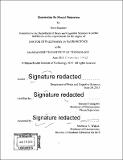Illuminating the mental memoriam
Author(s)
Ramirez, Steve (Ramirez Moreno)
DownloadFull printable version (42.55Mb)
Other Contributors
Massachusetts Institute of Technology. Department of Brain and Cognitive Sciences.
Advisor
Susumu Tonegawa.
Terms of use
Metadata
Show full item recordAbstract
Memories thread and unify our overall sense of being. With the accumulation of our knowledge about how memories are formed, consolidated, retrieved, and updated, neuroscience has reached a point where brain cells active during these discrete mnemonic processes can be identified and manipulated at rapid timescales. Here, I begin with historical studies that lead to the modem memory engram theory. Then, I present our recent advances in memory research that combine transgenic and optogenetic approaches to reveal underlying neuronal substrates sufficient for activating mnemonic processes. Our studies' conclusions are threefold: (1) we provide proof of principle evidence demonstrating that learning-related neural changes can be isolated at the level of single cells, and that these cells can then be tagged for subsequent manipulation; (2) a defined subset of hippocampus cells are sufficient to elicit the neuronal and behavioral expression of memory recall, as well as sufficient to modify existing positive and negative memories; (3) and finally, artificially activated memories can be leveraged to acutely and chronically suppress psychiatric disease-related states. We propose that hippocampus cells that show activity-dependent changes during learning construct a cellular basis for contextual memory engrams and that directly activating these endogenous neuronal processes may be an effective means to correct maladaptive behaviors.
Description
Thesis: Ph. D., Massachusetts Institute of Technology, Department of Brain and Cognitive Sciences, 2015. Cataloged from PDF version of thesis. Includes bibliographical references (pages 212-230).
Date issued
2015Department
Massachusetts Institute of Technology. Department of Brain and Cognitive SciencesPublisher
Massachusetts Institute of Technology
Keywords
Brain and Cognitive Sciences.